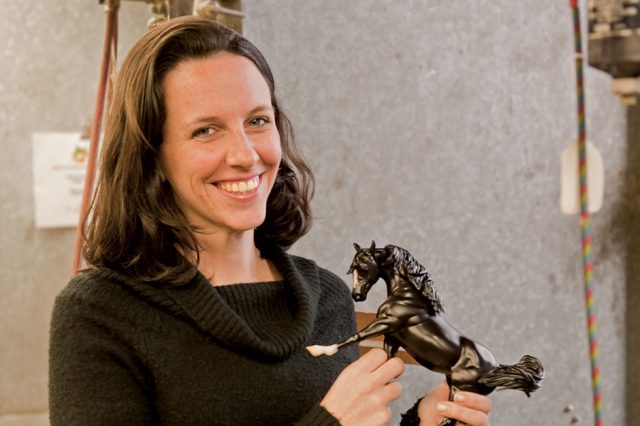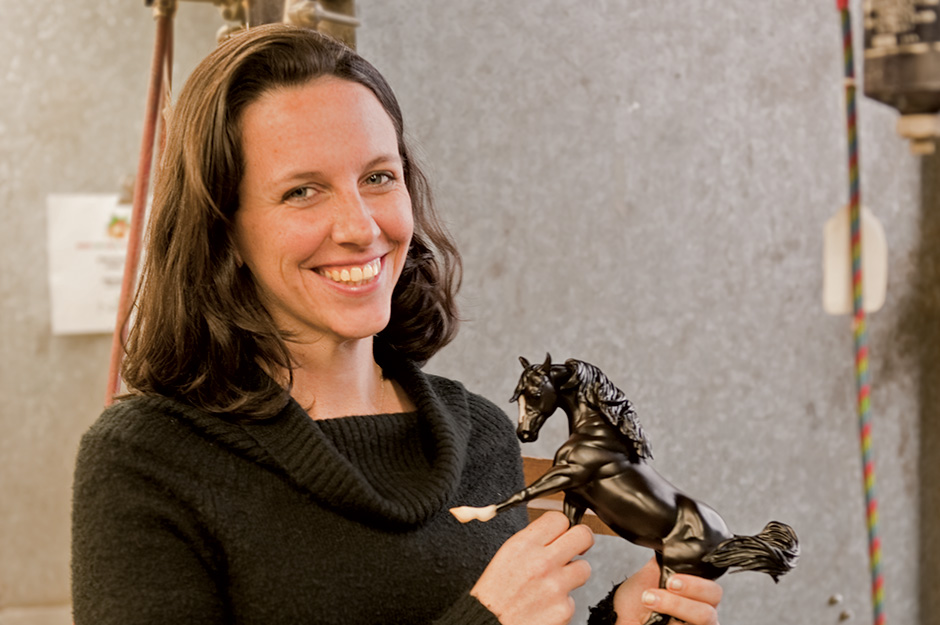As EQ’s departments editor, I got to fulfill what was my childhood dream…visiting Breyer and making my own horse into one of a kind.
My friends and I, like many young girls, played endlessly with our Breyer horses. The heavy plastic was perfect for clopping across my wooden floor. For my fifth birthday, my friend’s father handcrafted a Breyer-sized wooden barn, with everything from hooks for buckets to latches on the doors. For most of my childhood, the barn and the small hay bales and fences that surrounded it were the centerpiece of my room, only cleared away when parental nagging required it.
By high school, the barn was relegated to a corner of my room, and only my favorite horses remained up on a shelf. The others were packed up, without ceremony, and stacked in bins or pushed into the closet. My childhood self would have cringed envisioning my favorite horse friends standing illogically next to music posters and prom photos.
Now, years later, as the EQ team approached Breyer headquarters in New Jersey, I tried to picture my favorite Breyer horses and the names I had given them. What was once so important to me was now difficult to remember as we drove up to the rather ordinary-looking building.
In the lobby, there were wide, glass shelves filled with artfully-placed Breyers lit from all angles. Breyer President, Tony Fleischmann, and his associate, Kathleen Fallon, warmly welcomed us. The Breyer offices, constructed in what was until recently the site of model production, have the high ceilings of a warehouse and the crisp feel of modern renovation. Big, realistic stuffed animals of donkeys and dogs stand in the in the corners; the animals were discovered in the company’s old factory in Chicago when production moved to the east coast in the 1980s.
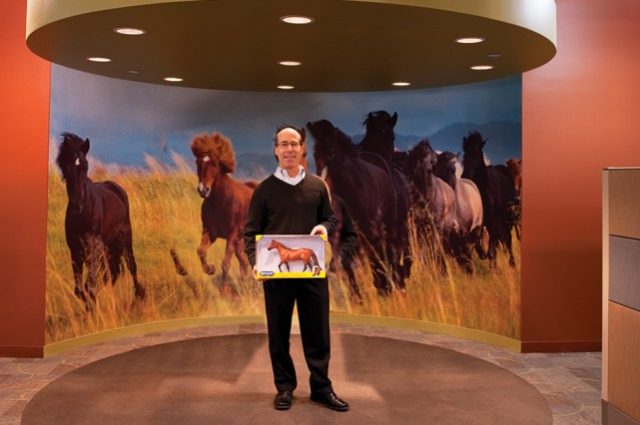
Tony’s father, Werner Fleischmann, the former president and founder of Reeves International, saw an opportunity in the market. None of the detailed, high-quality toys he remembered from his childhood in Switzerland were available in the U.S. So in 1946 Reeves entered the toy industry as the U.S. distributor of fine European toys and collectibles such as Corgi cars and Steiff stuffed animals. Meanwhile, the Breyer Molding Company created its first model horse, commissioned by F.W. Woolworth and made to adorn a mantlepiece clock. Requests flooded the company for the horse alone, and soon the company began to produce model horses. When Reeves purchased Breyer in 1984, it already had a long history with collectors, and today the Breyer Animal Creations brand is Reeves’ largest business.
Memories Flood Back
Though I was engaged and interested on an intellectual level, I’ll admit that I was not feeling the wave of nostalgia I had expected — until we entered the archive room! My breath caught in my throat. The long wall to the right was lined with thousands of model horses of every imaginable breed and color. To my left, row after row of tall shelves held uncountable equine forms, many priceless collector’s items. Some, we were told, were prototypes that were never made, for example a translucent tortoise-shell line. Others were one-of-a-kind, handmade gifts or special models to honor an occasion. Unique unicorns, dragon-horses, bears, and moose sat on shelves amidst the endless rows of every known horse breed, all with different molds and coloring. I recognized several from my friends’ and my collections, and my heart skipped a beat every time I passed another shelf.
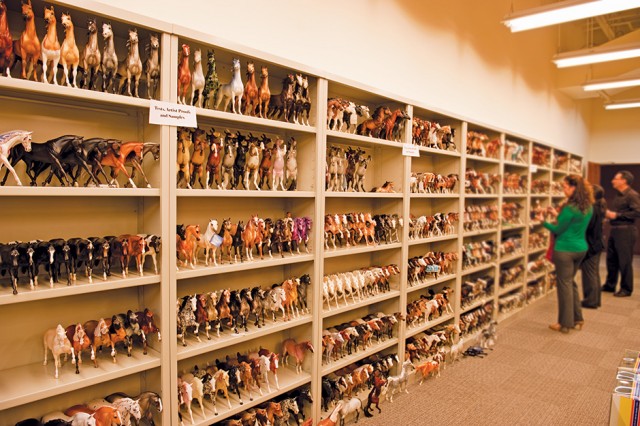
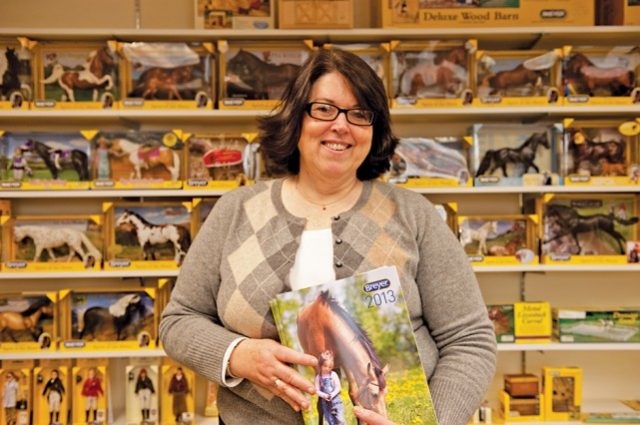
As Kathleen told us about the process of deciding which models would be produced, I found it difficult not to wander off alone to see what was around the next corner. My nostalgia flooded back, and and, aisle after aisle, I soaked in the magic that I had enjoyed as a child.
One aspect of Breyer horses that sets them apart is the process by which they are made. Whereas most toy companies create the simplest mold shape possible, Breyers are often made in several pieces. If the complexity of the tail or the musculature of the neck is too much for a simple two-piece mold, several pieces will be molded and attached and the glue lines carefully sanded away. The material itself, cellulose acetate, which is now used mainly for eyeglass frames, lends the models an artistic quality as well as the durability needed for even the most enthusiastic playtimes. However, some adult collector Breyers are made of porcelain or resin.
The Factory
Next we headed to the factory where the horses are made. Kathleen stopped to show us stacks of children’s letters and drawings offering ideas for models or pleading to have their horse made into a Breyer. Even the airbrush artists we met, who work for hours on each prototype, seemed to understand the greater meaning of their products.
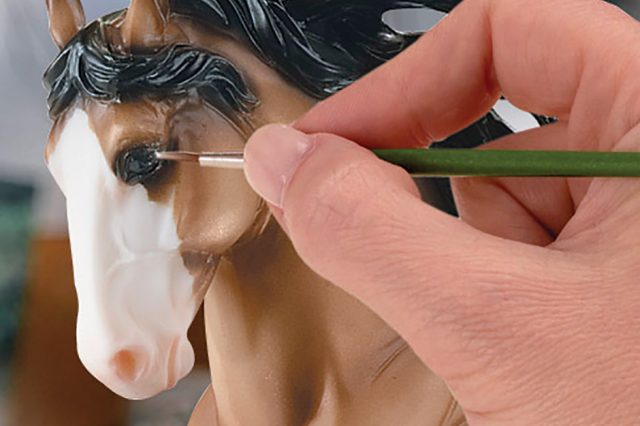
I stood with an artist named Sam for several minutes as he explained the airbrush painting process. I asked him how he knew so much about the markings and musculature of horses. He told me about his father’s veterinary practice in Puerto Rico and the love of animals animals he’d had as a child. He took me to see Margarita, who was adeptly drawing dapples onto a thick, Irish-looking draft model. Her airbrush circled smoothly and carefully over the horse, leaving a trail of astoundingly-realistic dappled coat.
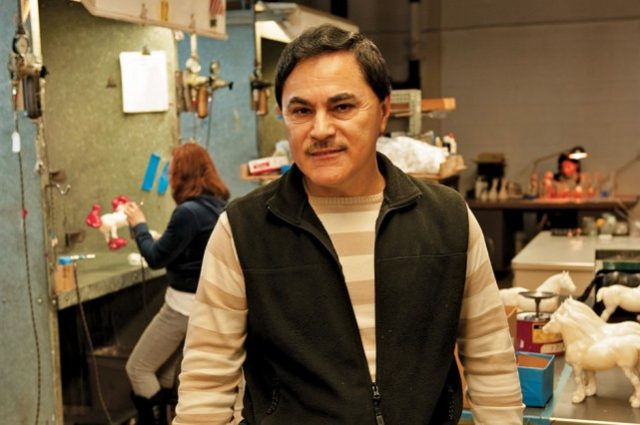
The artists that had joined us on the factory tour laughed with each other about how poorly they had airbrushed when they had first begun. “Why don’t you try your hand?” they asked. My cheeks flushed. To think! Me making a Breyer horse! As Sam gently showed me how to hold the brush and control the airflow, he asked me if I had a horse. I realized he was offering me the chance to create my own horse, Fedor, as a Breyer! I prematurely listed in my mind the people I would tell about this — and which of my friends would understand the significance.
He expertly mixed some paint and hooked up the brush for me. My attempt went surprisingly well, and the artists assured me they could fix any mistakes I made. I painted a light red-brown coat and felt disappointed that it didn’t look like my horse at all. Then Sam attached a different color to the airbrush and explained how the color is built up in layers. He demonstrated how to paint at an angle from the back, and I started a second coat of paint. This one was pure black, and as I added it lightly over the brown, it transformed immediately into a perfect dark bay.
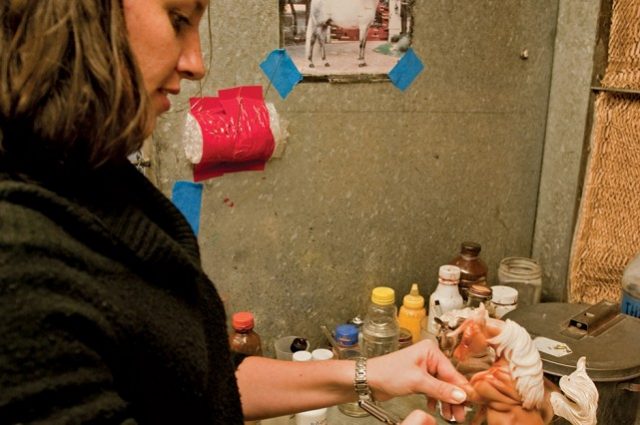
Those familiar with Breyer horses can certainly understand my excitement. I had once felt my childhood imagination add life to these realistic plastic models. The realism of Breyer horses made imagining so easy. And to hold my own horse at a 1:9 scale, to know that this was not some product of a production line but a miniature version of my dearest friend, overwhelmed me with a combination of excitement and nostalgia. Perhaps years too late, but it was utterly magical nonetheless.
For most of my childhood, Breyer horses, a model barn, and the small hay bales and fences that surrounded it, were the centerpiece of my room. Now, twenty years later, my horse Fedor, had just become a Breyer!
